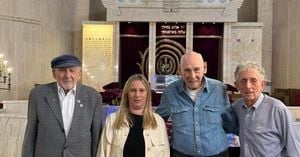On Wednesday, October 15, 2025, the East Room of the White House was abuzz with the kind of energy only a gathering of the nation’s most powerful business titans and political heavyweights can create. President Donald Trump, never one to shy away from spectacle or ambition, played host to more than three dozen wealthy donors and corporate executives for a lavish dinner—a celebration with a singular purpose: to thank those funding his long-envisioned $200 million ballroom addition to the White House.
The guest list, as reported by The Wall Street Journal and corroborated by The Hill, read like a who’s who of American corporate might. Representatives from Microsoft, Google, Apple, Amazon, Palantir, Lockheed Martin, and Coinbase mingled with billionaire supporters such as Blackstone CEO Steve Schwarzman, oil magnate Harold G. Hamm, and the Winklevoss twins, Cameron and Tyler, known for their crypto exchange Gemini and substantial contributions to pro-Trump PACs. Also in attendance were leaders from Meta Platforms, T-Mobile US, Hard Rock International, and a host of philanthropic foundations.
“We have a lot of legends in the room tonight, and that’s why we’re here to celebrate you, because you gave, given tremendous amounts of money to see a ballroom for the first time at the White House,” President Trump told the assembled crowd, according to The Hill. He then dramatically opened the curtains in the East Room to reveal the future site of the ballroom, a gesture that drew murmurs of approval from the attendees.
The ballroom project, which will be constructed adjacent to the East Wing, is planned as a 90,000-square-foot space boasting bulletproof windows and a seating capacity of up to 999 people—though earlier White House statements cited 650 as the expected number. The venue is designed to host State Dinners, major events, and to provide the kind of grand setting that, as Trump put it, American presidents have long needed but never realized. “The White House for 150 years-plus, they wanted to have a ballroom, and it never happened because they didn’t have a real estate person,” he quipped, drawing laughter from the crowd.
According to The New York Times, Trump was effusive in his gratitude, noting, “So many of you have been really, really generous. I mean, a couple of you, I was sitting here and saying, ‘Sir, would $25 million be appropriate?’ They said, ‘I’ll take it.’” He even suggested that some donors had offered to pay more than $20 million each—a testament to the deep pockets and loyalty of his backers.
Funding for the project will come entirely from private donations, not taxpayer dollars, a point repeatedly emphasized by White House officials and the president himself. “The American presidents need to be able to showcase our country,” Trump said, underscoring the urgency he feels for the new ballroom. In the past, large White House gatherings were often held under tents on the South Lawn, a solution Trump clearly found lacking in both prestige and security.
Yet, as the plans for the ballroom move forward, so do the questions and criticisms. Ethics watchdogs have raised concerns about the optics—and potential realities—of pay-to-play politics. Richard W. Painter, who served as chief ethics lawyer in the White House Counsel’s Office under President George W. Bush, didn’t mince words in his assessment. “Getting an invitation to the White House to a dinner because they’re contributing to the construction of this project,” Painter told The New York Times, “This is payment for access, not just to the grounds of the White House but access to the president of the United States.”
Despite these criticisms, Trump and his aides have remained steadfast, insisting the ballroom is a necessary and overdue addition. They point to the practical and symbolic value of having a grand space to host foreign dignitaries and major national events. “The American presidents need to be able to showcase our country,” Trump reiterated on Wednesday night.
Beyond the ballroom, the evening also featured a sneak peek at other ambitious projects. Trump displayed models of a new arch planned for construction near Arlington National Cemetery, and he didn’t hesitate to reference other changes he’s made around the White House—paving over the Rose Garden grass, redecorating the Oval Office, and more—all part of his ongoing campaign to leave a lasting mark on the nation’s most famous residence.
The president’s remarks wandered through a wide range of topics, as is often his style. He touched on controversial subjects such as statues of Confederate generals, his administration’s military strikes on boats near Venezuela—actions that, according to The New York Times, have been justified as anti-drug operations but have drawn scrutiny for their secrecy and legal ambiguity. “In fact, nobody wants to go fishing anymore,” Trump joked, referencing the fear his administration’s aggressive tactics have inspired. “No one wants to do anything near the water. They might have a beautiful boat and they might as well get rid of their boat because they’re very nervous.” The quip drew laughter from the room, but the underlying message was clear: Trump’s approach, whether to White House renovations or foreign policy, is bold and unapologetic.
He also acknowledged that some of the business leaders present were not always on his side, but had come around as his political fortunes improved. “It’s amazing the way a victory can change the minds of some people,” Trump observed with a grin, highlighting the pragmatic alliances that often define Washington’s corridors of power.
According to The Washington Post, Trump announced that the ballroom project is already fully financed, with money left over—a remarkable feat, given the scale and cost of the undertaking. Companies such as Coinbase and Apple, among dozens of others, have committed millions, ensuring that Trump’s “long-desired state ballroom” will soon become a reality.
With so much money and influence concentrated in one room, and with the promise of a new era of White House hospitality on the horizon, the dinner was more than just a fundraiser—it was a statement of intent. Trump’s determination to reshape the White House, both physically and symbolically, is unmistakable. Whether the ballroom will be remembered as a crowning achievement or a lightning rod for controversy remains to be seen. But for now, the project has the green light, the checkbooks are open, and the East Room’s curtains have been drawn back to reveal a new chapter in presidential pageantry.
The ballroom’s construction stands as a testament to the enduring interplay of power, ambition, and money in American politics—a reminder that, in Washington, the walls may be historic, but the stories they contain are always being rewritten.



